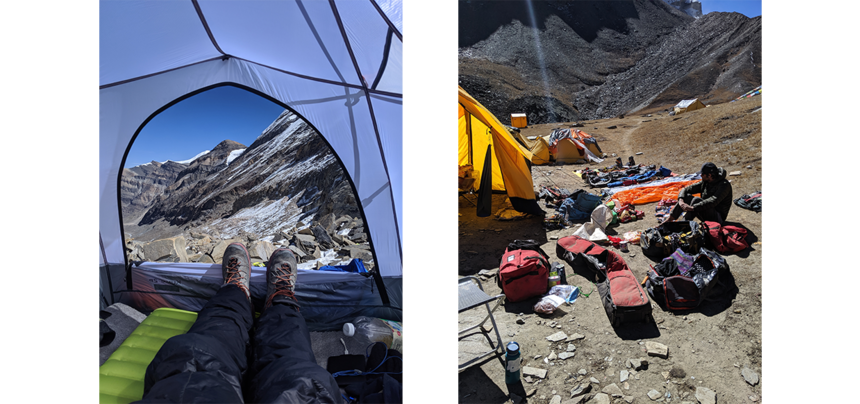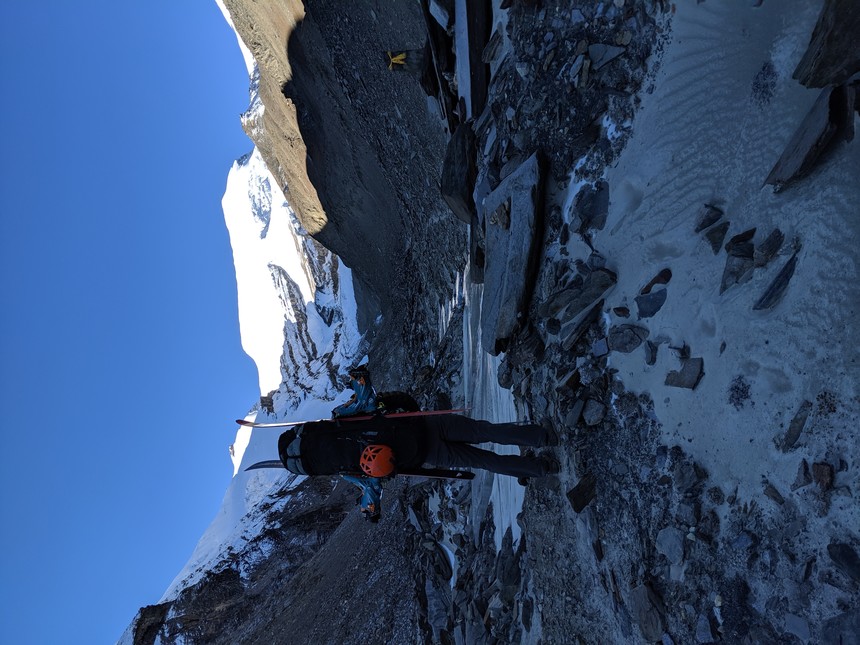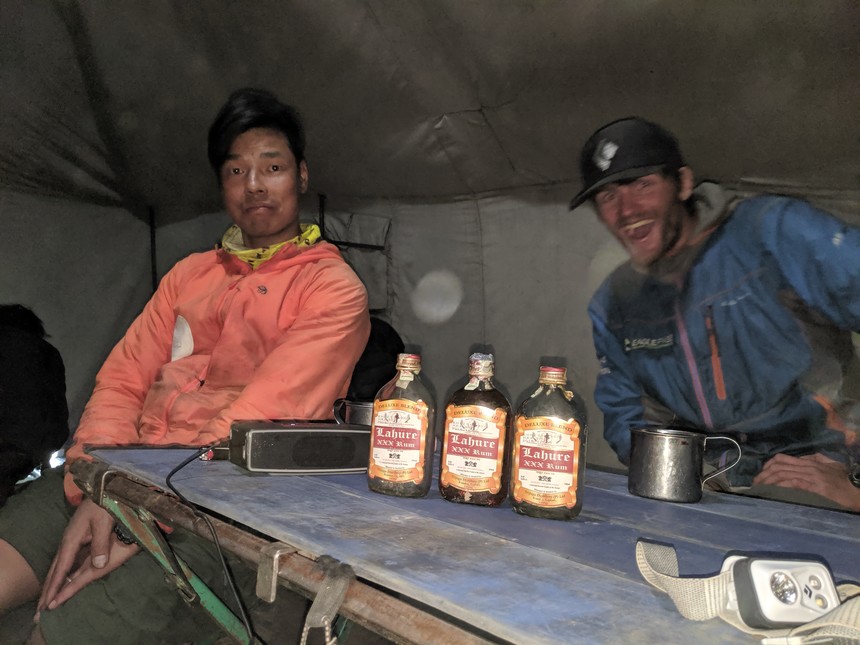
Dancing with the Devil on an expedition to climb and ski the Himalayan giants.
Dhaulagiri VII Dreams
Story by Elliot LeveyHere’s the deal: Drew and I are not professional athletes. But we did decide to go ski mountaineering in the Himalaya. Sure, we’ve done plenty of bold stuff together, from first descents in Alaska to volcano skiing in Russia, traverses in British Columbia and steep skiing in the Sierra-Nevada. But when you’re in basecamp at 16,000 feet, looking up another 10,000 to the summit of your objective, everything changes. We went to Nepal to climb and ski two mountains: 20,008-foot Chulu Far East and 23,774-foot Dhaulagiri VII. We did them backwards, going for the taller mountain first, because we wanted to “totally shred!” the lower altitude Chulu group. We would slowly come to learn how unrealistic that idea really was.
The core reason for our pursuit was that we froth on adventure. My other reason, perhaps even more important, was drawn from the fact that I believe seeking out tribulations in the mountains helps define questions about the Self. “What am I? What am I capable of? How great is my self-sufficient potential?” Sometimes mountaineering doesn’t give complete answers to those questions, but it does help reveal your priorities, which leads to the questions you should be asking.
With as little support as possible (no climbing Sherpa, minimal basecamp support, and obviously no oxygen) and partly because of our own self-righteous need to prove ourselves as hardmen, we set off into the hills. Stylistically, our ethical approach was directed out of tribute to the folks who got it done back in the Golden Age of mountaineering, to gain some of their invaluable insights about life in general. So, being the mountain people that we are, Drew and I decided to go have an adventure in the Himalaya. The story that follows is part one of that adventure.

One local warming up next to a morning flame. A few villagers are happy to lend us a helping hand to earn a few rupees.
Just Getting There
On September 29 we boarded a bus in Kathmandu. 27 hours later we arrived at a very remote village, the name of which I couldn’t pronounce. The driver was a slick looking 20-something who drove the entire route without a break and whom I watched eat about a whole can of dip from small packages called Mega Shree while gumming a local white drug that’s basically cocaine. Well, the bus ride was absolutely heinous. Cramped seats, no airflow, blasting music. Our legs were too long to sit comfortably, let alone sleep. But at least we had seats. Elsewhere onboard, people sat on bags, buckets and backs in the aisle. Old and young, piling on top of everyone. We stopped every so often to get a snack, never more than 10 minutes. Whenever we did, more hitchikers got on. I slept a little. The two babies on board slept a lot while their mothers vomited into plastic bags and threw them out the window along with everyone else who was car sick. As darkness fell on our bus for the second time, we reached a small rain-drenched village at the road’s end. Dhaulagiri VII was still very far away.
I woke up that first night after the bus at midnight on a wooden cot on the second floor of a small stone house. I groaned and rolled with aching muscles and joints, a splitting headache and leaking nose. I was covered in sweat, having terrible nightmares. I felt exhausted from the sleep-deprived bus ride already, and hoped to feel better in the morning for the start of our Jeep connections that would fill the next three days of travel.
In the next 72 hours we took 11 separate jeep rides through some very foreign territory. We would cover a stretch of drivable road, then unload our gear and carry it across the river to the other side where it wasn’t washed out. At the end of the Jeep road lay a relatively large town called Dunai, whose population was last recorded in the year 1991. When I woke up with a dripping nose, watering eyes and scratchy throat, I realized I had been allergic to the ubiquitous herds of asian livestock we’d been driving through and living amongst this whole time. I loaded up on what my best guess was an anti-histamine from a small apothecary in the village. I was close to the line of excessive fatigue after our jeep saga ended, and we hadn’t even started the 55-mile walk to basecamp.

Traffic in the Dolpa, and thank you Reinhold Messner for inventing Fast and Light.
We loaded up six horses, three porters and laced our boots to commence the trek. Day 1 was a moderate four-hour jaunt through the valley, next to the river. We hiked under an uncomfortably beating sun. Once we got to Tarakot where we would make camp for the night, I laid out my sleeping mat in a field next to a derelict stone structure that others were congregating in. My chills were overwhelming so I dug out rain pants and a jacket just to keep warm, and pulled into my sleeping bag. The next thing I knew I was standing in the middle of the field in just my shorts, sweating profusely. It was pretty apparent now that I had a severe fever.
The next nine days made up our voyage to basecamp. Normally I’d be able to shake an ailment like this in a few days but the demands of traveling in the mountains would not allow it. Regular doses of Western medicine allowed me to press on. Every hour, I needed to rest as we climbed through the hills, and I would collapse on any cool rock for 10-15 minutes before getting back on my feet. Every breath I took felt like a spiked vice clamping down on the back of my throat, especially when we passed through storms of dust kicked up by 100 stampeding goats. I was able to take a full 24 hours of rest on Day 7 in Karakot, where I barely moved at all. We were at about 11,500 feet, the next day pushing to 13,800 and then to basecamp at 16,000. It’s a big jump that would hurt any way you cut it.
Acclimatizing
October 11 marked our first voyage above basecamp. We traveled through the glacial moraine with relative ease; the path worn in by fellow climbers was light though recognizable and somewhat intuitive. The air was certainly thin around 18,500 feet, and we slowly managed to secure our tent without much trouble, cutting extra guy lines out of p-cord and cinching them around rocks to wedge in more scree, as Camp 1 is nothing more than a boulder field.

Our spot at Camp 2, set up so we could skip Camp 3 and head straight for the summit.
We returned to basecamp in the evening and dropped packs somewhere near our tent. We were by far the smallest team out of the five others on the mountain, just Drew and I with no climbing support. We dared not peek inside the others’ tents, for plates of charcuterie, spurts of mist rising from freshly chopped vegetables, propane space heaters, branded lounge chairs and hot shower bags would make you envy. Our skeleton mission and staff of four (including ourselves) looked quite different. We dined in a simple eight by six-foot T-bone style tent. Drew and I hunched over soup bowls to let the steam warm our cheeks. Ice covered the walls as we sacrificed our lumbars to sit on two shitty folding stools. Conversation was held between two shadow covered faces straining not to knock anything over on the dirty, rusty folding table balancing on the sloping dirt.
I sipped instant coffee with dehydrated milk powder as we reviewed our plan. We intended to slog back up to Camp 1 to sleep. I felt that I am not yet acclimatized, but Drew was, steadfast to keep pushing higher. My backpack to Camp 1 felt heavy. In the morning we loaded up at Camp 1 and pushed to Camp 2. I realized then that I had forgotten my skins in basecamp, and had to bootpack up to 21,500 feet with the extra weight of the skis on my pack. It was annoying, to walk between the glacier and the rocks, as the boulders were too loose for ski boots, and the snow too unsupportive to stay on the surface. After every few steps, I felt like I was drowning in the thin air, gasping for more oxygen.
When I got to the col some 300 feet below Camp 2, I could see that Drew (with skins) had already ascended to camp. I tried to radio him but it did not go through. Soon after, I saw him skiing back down the route, and I started to build a cache for my Camp 2 gear. I dug a hole in the snow and marked the cathole with a bamboo wand borrowed from a nearby crevasse. We skied back down to Camp 1, repacked some gear, and then slogged down through the boulder fields to basecamp.

Single-wall two man tents are delightful for just one. All gear had to be repacked for the horses and yaks on the way out.
After another cycle up the mountain to stash more food and fuel, we left for Camp 2 with hopes of both finishing the peak. We were skeptical of the forecast received, which dictated cloudy skies, chance of precip and wind. We ascended past Camp 1 as usual, and I felt particularly strong. But upon reaching Camp 2, I was extremely tired. I had a severe headache that I could not lessen, even after 800mg of ibuprofen and 250mg of Diamox. We lay in the cramped tent at Camp 2 as I groaned and tried to push the pain out of my skull while it was my turn to melt water. Over the next two hours, I felt the pressure building greater and greater inside my head and was very concerned that I would suffer from high-altitude cerebral edema. I made the decision to descend, and gave Drew my film camera for the summit shot. I left the tent at sunset and started to ski down to Camp 1, the usable light leftover from sunset being crucial to avoid the gaping crevasses that could digest me whole. It got dark very quickly.
Defeat
Once I reached our tents, I collapsed against a rock, staring up into the dark, flickering abyss while wind whipped at the tents and the side of my hood. I realized in that moment that I do not quite enjoy being alone as much as I usually profess. The moon did not come out for some number of hours later. Usually, I am unequivocally impressed with the depth of the stars, but by then I was so worked that I felt completely empty. After another round of dry-heaving, I took an Imodium and another 400mg of ibuprofen and drifted off to sleep.

Never stop looking up.
I woke up to Drew stumbling around camp unzipping the tent around 7:45 a.m. I did not expect him to be in such poor shape. He spilled into the tent, his down suit taking up all the extra space. I fed him some M&Ms and gave him my water bottle, concerned as he shook uncontrollably trying to lift the bottle to his mouth. He mumbled that he had to get out of the tent, and five seconds later was doubled over vomiting outside. He was in a bad way, though reported of successfully reaching the summit. He thinks he left the tent at Camp 2 around 3:30 a.m. and summitted by 7 a.m. We eventually made it back down to basecamp where I became more curious about his delirium. Our cook asked him what time it was, to which he responded, “It must be about 3:30 p.m.” I corrected him, in that it was only 10:45 a.m. I would have one more attempt to solo the route a few days later, but did not make it past Camp 1.
Finding Myself
I believe that someone must pursue these extremes and push the boundaries, competencies, and capacities of the human spirit. But today, the call for me to go sounds with a less demanding tone. For me, mountaineering is always about self-discovery. In the past I’ve defended my pursuits in the mountains by saying,“I will come back a better version of myself, to better serve my community.” I’m not convinced that this is truly what happens. I am not obsessed, but I respect and love this sport to the fullest. It has taught me incredible things about myself: humbleness, humility, trust, unknowns, doubt, hesitation, treading lightly and respect. It has certainly shown me that there are more valuable lessons in failure than success.

Guaranteed best rum in all of Nepal.
I want to know where my bedrock is. The path to self discovery and actualization must have dead ends. Isn’t that exploration? Where is the limit? To search and search without finding an answer is unfulfilling. To uncover the solid foundation is a source of sanity.
The modality of the mountain is arbitrary, like a blank canvas on which the artist paints. The value is in the absolute effort of the climber, while staying alive. Summiting is only the cherry on top to the sundae of the mountaineering process. To embed oneself within nature is necessary; to conquer nature is an exercise in futile egoism. It is more meaningful to express oneself in your environment, than to conquer it wholly. It’s not about the mountain, it’s about you. I am a free person, and I choose to use 100 percent of myself, squandering nothing. To drive yourself to the bottom is the ultimate display of self control, and your succeeding float back to the surface - knowing that you made it to your limit - is the sweetest reward.
One of my last duties in this particular project was to bring the entirety of Camp 1 down to basecamp in a single load. As I labored under the hot sun beating down on my 80-pound pack in the mental shadow of perceived failure, I felt the most accomplished. At my lowest, most thrashed point of being, I felt the strongest, and convinced of the truth of my route. Upon reaching basecamp, I had only the wherewithal to stick my head in the creek and then stare at my shoes. The boys came out and Radna asked me if I wanted some hot tea. He didn’t have the capacity to purify cold water, so I had to wait another 30 minutes while my purification chemicals reacted. I went to go lay in the grass by the creek and dry heave while I waited. I cut a few minutes off the recommended waiting time and skulled 1.5 liters of water in under five minutes. The ice cold liquid plummeted my core body temperature, so I got into the tent and blissfully shivered off to sleep, looking forward to the 55-mile walk back out of the Himalaya in the morning.

Onward to the Annapurna.
In the next two weeks, we would travel back across Nepal to re-rack and attempt Chulu Far East. We both stood on the summit together in screaming winds after a truly grueling climb. Although I satisfactorily compartmentalized my failing to conquer Dhaulagiri VII, I will say that it still feels good to reach summits.
